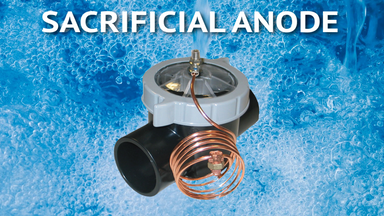Published by Matt Fichera on 01/16/2023
What is a Sacrificial Anode for Your Swimming Pool?
A sacrificial anode is a simple device that is easy to install and economical. It works to preserve and protect metal components of a swimming pool’s operating system from salt water corrosion. It conducts electricity when currents pass through it during electrolysis. Electrolysis is what a salt system uses to produce its own chlorine. These types of anodes are readily available in many different shapes and sizes depending on equipment size and exact placement within the pool system.
Zinc and aluminum sacrificial anodes are commonly used in environments where salt water is present due to its lower resistivity. These anodes are essential for protecting various metal structures from corrosion in such settings. Specifically, they're utilized on the hulls of ships and boats, which are constantly exposed to harsh marine conditions. Offshore structures like pipelines and production platforms also rely on these anodes to combat the corrosive effects of salt water.
Additionally, marine engines that are cooled using salt water benefit from the protective effects of zinc and aluminum anodes. Smaller components such as boat propellers and rudders, which are frequently submerged, also require these anodes for corrosion prevention. Finally, the internal surfaces of storage tanks containing salt water often employ zinc and aluminum anodes to maintain their integrity over time.
How Does a Zinc Anode Work?
Did you know that if you have a salt water chlorination system in your swimming pool that anything which is metal and immersed in the water, is actually producing an electrical charge? This means any metal components are also at risk of corrosion, especially over extended periods of time. The anode “sacrifices” itself from any electrical charge that may flow into your water and works to preserve other components like ladders, steps, filters, fittings, light fixture housings, or components of a pool heater.
A zinc sacrificial anode works to protect metal in your pool through a process called cathodic protection. Zinc, by definition, has a more active voltage than the other metals and will break down before any damage is done to the surrounding metal materials. Oxidation and reduction take place on the sacrificial anode and not the other metal components located in your pool.
The effectiveness of this method lies in the difference in potential between the zinc anode and the metal structure it protects. This potential difference ensures that the zinc anode corrodes preferentially, sacrificing itself to prevent corrosion on the structure. This process effectively halts the oxidation reactions that would otherwise occur on the metal of your pool, ensuring it remains intact and undamaged.
By understanding this electrochemical interaction, you can appreciate how zinc anodes play a crucial role in extending the life of metal structures by diverting corrosive reactions away from the materials you want to protect.
An anode should last anywhere from 6 to 12 months and it’s important to keep tabs on its condition and replace if considerably broken down or degraded. Good times to check the anode are during both pool closing and opening or once in the spring and once in the fall, if your pool is open year-round.
Is a Sacrificial Anode Always Needed?
It is difficult to say if a sacrificial anode is absolutely needed with every saltwater pool. Different variables come into play, such as overall water chemistry and any types of metals that exist in your pool’s system. Perfect pool balancing remains a hard thing to conquer, and even when pH is at a perfect 7.4, there remain other factors such as alkalinity and chlorine production that can cause galvanic corrosion. Another factor to consider is the type of metal making up the components in the pool. Modern ladders, steps, and light housings are composed of stainless steel that resists corroding, but older accessories could be made of a lower-grade steel or steel plating that is more susceptible to corrosion.
For the sacrificial anode method to be effective, several key conditions must exist:
- Presence of Anode and Cathode: These are crucial for the electrochemical reaction that prevents corrosion.
- Return Current Path: There must be a path for electrons to flow from the anode to the material it protects, typically through physical contact.
- Electrolyte Availability: An electrolyte, such as water or humidity, is needed to convey the electrons effectively.
Understanding these conditions helps in evaluating whether a sacrificial anode is necessary for your specific pool setup. By assessing both the chemical environment and the materials involved, you can better protect your pool from corrosion.
Advantages of Using Sacrificial Anode Systems Over Other Cathodic Protection Methods
Sacrificial anode systems offer several benefits that make them a preferred choice for cathodic protection in various applications:
- No External Power Source Needed: Unlike some cathodic protection methods that require ongoing electrical power, sacrificial anode systems operate independently, ensuring reliability even in remote locations.
- Ease of Installation: These systems are simple to set up, making them accessible for a wide range of projects without requiring specialized tools or training.
- Minimal Risk of Stray Currents: The natural, low-voltage and current operation between the anode and the protected surface minimizes the generation of stray currents, reducing potential harm to surrounding structures and environments.
- Reduced Risk of Overprotection: Sacrificial anodes provide a balanced level of protection, making it unlikely to cause damage due to excessive current, unlike systems that might inadvertently overprotect.
- Simplified Inspection and Monitoring: Inspection routines are straightforward, allowing trained personnel to easily assess system performance and maintain effectiveness without complex equipment.
By offering these practical advantages, sacrificial anode systems present an efficient and user-friendly solution for corrosion protection.
Where Do You Install a Sacrificial Anode?
If you have made the decision to go with a sacrificial anode, the most important part of installing it is to ensure that it is connected to the bonding wire of your pool system. This bonding wire should encompass your entire electrical system of your pool and by connecting the anode to this system, you are protecting it in its entirety. The most ideal spot to place an anode is as an “in-line” device between the filter and the heater. It sits in a “T” PVC junction and is easily plumbed into the system by a handy pool owner or a service technician. Once this is completed, the anode can usually be replaced by simply unscrewing the cap. Replacement should be expected every 6 to 12 months.
Would We Recommend a Sacrificial Anode?
The answer is “Yes”, we would recommend a sacrificial anode as an affordable way to have peace of mind and to prevent potential costly damage to hardware or sensitive pool surfaces. There are different types available on the market, which include devices that sit in your skimmer basket to more complex products that plumb into your swimming pool’s system. If you don't mind spending a bit of money you will be glad you decided on adding this handy device to your salt water pool. At EZ Pool & Spa Supply, we offer different types of anodes available for purchase and would be happy to help answer any questions that you may have.





